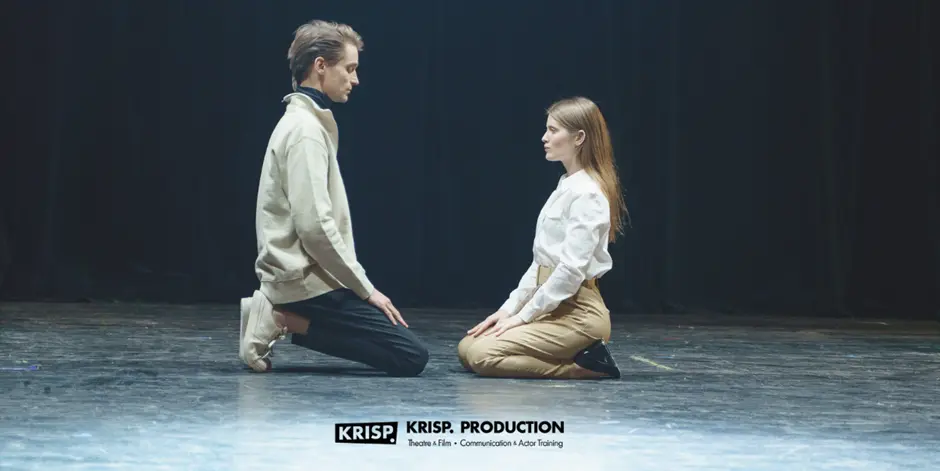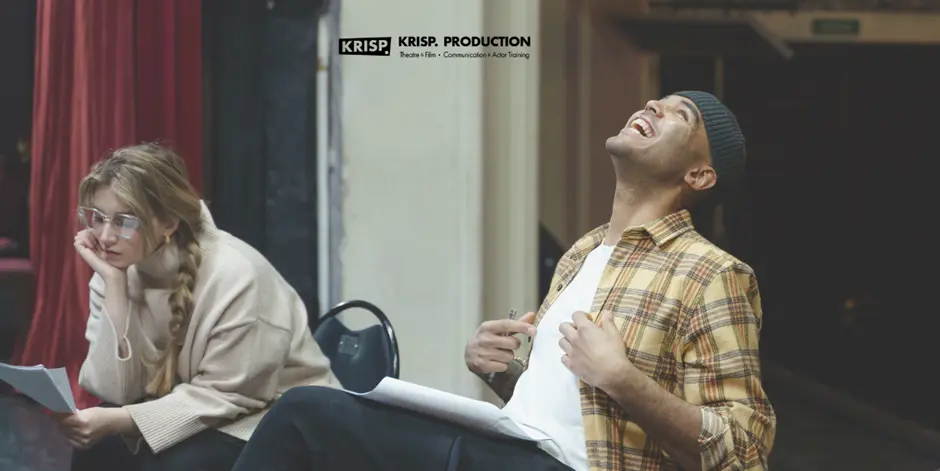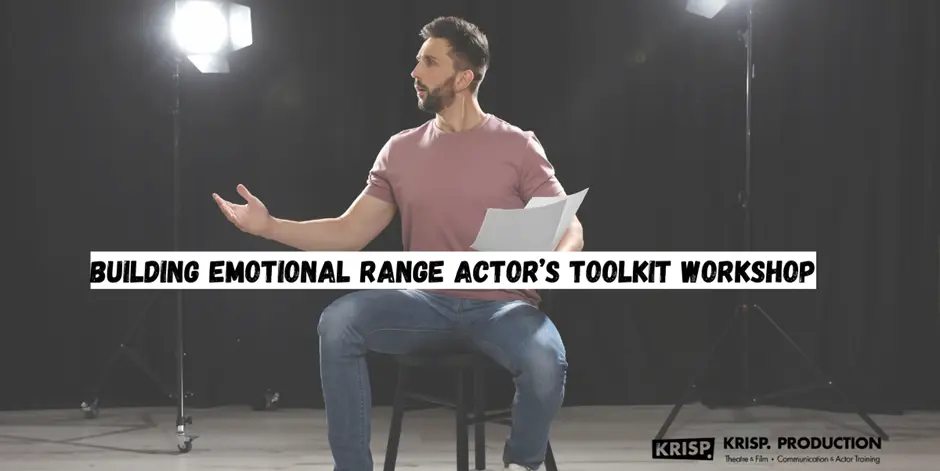Building Emotional Range: Actor’s Toolkit Workshop
Emotional range is your ability to access and express different feelings authentically on cue. It’s what separates actors who book roles from those who keep hearing “we’ll call you back.”
Without this skill, you stay stuck performing the same flat emotions in every audition.
The good news is that building your emotional range for acting in Singapore doesn’t require you to relive personal trauma or drain yourself mentally.
At Krisp Production, aspiring actors learn techniques like the Michael Chekhov and Meisner approaches that help you access any emotion on demand for screen acting, stage work, and film auditions.
In this guide, we’ll cover:
- Why emotional range separates working actors from those waiting for callbacks
- Safe techniques that expand your craft
- Practical exercises you can practice anywhere in Singapore
Ready to enhance your acting abilities? Let’s get started.
Why Emotional Range Is Important for Aspiring Actors
Your emotional range separates you as an actor who works consistently from those waiting for callbacks that never come.

Think about the last time you watched a great performance on screen or stage. The actor probably shifted from laughter to tears within the same scene, and you believed every moment. That’s the power of developed emotional range, and it’s what casting directors look for in auditions.
The uncomfortable truth is that Singapore’s film and theatre industry rewards actors who can shift between contrasting emotions within the same scenes. When you can only play one note, you limit the roles available to you.
What makes this worse is that directors need actors who bring versatility to their productions at venues like the Esplanade or on MediaCorp sets.
But here’s where it gets interesting. Your career longevity depends on this versatility because the actors who work most often are those who can handle comedy one day and intense drama the next.
We suggest considering how audience connection requires authentic expression, too. Because viewers at professional theatre performances feel the truth in your performance when emotions are genuine, not performed.
When you access real feelings instead of surface-level reactions, people stay engaged throughout your work. The reason this is important for your success is simple: authentic emotion creates memorable performances that lead to more opportunities.
And then there’s the technical side. Screen acting demands subtle control that stage work doesn’t always require. The camera captures every micro-expression, so your training helps you convey complex feelings through tiny shifts in your eyes or mouth instead of big theatrical gestures.
Film directors can spot forced emotions instantly on camera, which is why actor training in emotional range becomes necessary for anyone serious about their craft.
Now that you understand why emotional range is important for your career, let’s explore how to build this foundation without burning out.
Building Your Emotional Foundation Without Burnout
What if you could cry on cue without reliving your worst breakup or access anger without screaming yourself hoarse? You might be wondering if that’s even possible.

The answer is yes, and it starts with understanding that your body holds pathways to emotions without forcing your mind to replay painful memories.
Here’s how you can develop emotional range while protecting your mental health.
Physical Pathways Replace Memory Recall
The Michael Chekhov Technique uses your body’s natural responses to create emotions without draining you mentally. Instead of thinking about sad memories to cry, you explore a heavy, sinking quality in your chest that naturally brings tears.
When you work with physical sensations like this, you access genuine feelings without the emotional exhaustion that comes from constantly reliving trauma. Actors at Krisp Production workshops find they can perform intense scenes multiple times without feeling depleted afterwards. Your nervous system responds to physical cues just as powerfully as it does to thoughts.
Breath Patterns Give Instant Access
Your breathing changes with every emotion, and you can use this connection in reverse. For example, rapid shallow breaths trigger anxiety, whereas slow deep breathing brings calm.
We recommend practicing these patterns for 10 minutes daily near Marina Bay or in your HDB flat, and you’ll see how quickly your acting abilities improve. Professional actors in Singapore use specific breathing techniques before emotional scenes in film and theatre productions.
Meisner Repetition Exercise Builds Authentic Reactions
The Meisner technique teaches you to stop performing emotions and start genuinely responding. By repeating simple observations with a partner, like “you’re smiling” and “I’m smiling,” you train yourself to react truthfully instead of planning how you think you should feel. This foundation work prevents the fake, forced quality that affects many beginning actors in classes.
Once you’ve learned these safe techniques for accessing emotions, you’re ready to explore specific exercises that expand your range.
Practical Exercises to Expand Your Range Today
The beauty of these exercises is that you can practice anywhere in Singapore, from your HDB flat to outdoor spaces, without expensive equipment or studio time. If you’re ready to enhance your craft, here’s where to start.
Emotional Scale Drill for Precise Control
- Choose one emotion and practice levels 1 through 10
- Level 1 anger might be a slight eyebrow furrow, while level 10 is full rage
- Film yourself at different locations like Marina Bay or Clarke Quay
- Review what shows on camera versus what you feel internally
- This trains you to control emotional intensity with precision
- When directors ask for “a little more” or “pull it back,” you’ll know how to adjust
Quick-Shift Improvisations Challenge Your Flexibility
- Set a timer for 30-second intervals with a scene partner
- Have them call out different emotional states rapidly
- Jump from excitement to grief to suspicion without hesitation
- This mirrors real audition scenarios where directors want to see your talent in minutes
- The pressure forces you to stop overthinking and trust your instincts
- Film and theatre productions require these quick transitions within the same scene
Viewpoints Training Connects Emotion to Movement
- Walk through the Botanic Gardens or Orchard Road crowds while holding an emotional state
- Notice how the emotion changes your tempo and how you move through space
- Pay attention to how your body posture shifts with different feelings
- This physical awareness prevents you from standing stiff while delivering lines
- You stop living in your head and start embodying emotions physically
We’ve seen that these exercises help actors develop the character development skills and confidence that casting directors look for in professional workshops and auditions.
Your Next Steps in Actor Training
Now that you understand the framework for building emotional range, the real work begins with consistent practice in your life.
Start with one technique that resonates with you. If you’re drawn to physical approaches, explore the psychological gesture work from the Chekhov method. If an authentic connection feels more natural, master Meisner repetition exercises with a trusted scene partner. The choice depends on your learning style and what feels right for your process.
Set aside 15 minutes daily for practice. Track which emotions come easily and which feel blocked. This self-knowledge is essential for your success in screen and stage work.
Professional actors know that emotional range doesn’t build overnight; it develops through regular training and commitment to your craft.
Join workshops where you can safely explore without judgment. Programs at Krisp Production help you develop skills while avoiding common mistakes like pushing too hard or relying solely on personal trauma.
With proper guidance and support from experienced teachers, you’ll build sustainable acting abilities that serve your entire career in film, theatre, and beyond.
Also Read-Smart Design at Sea: How Integrated Tech is Optimizing Space and Experience Onboard

